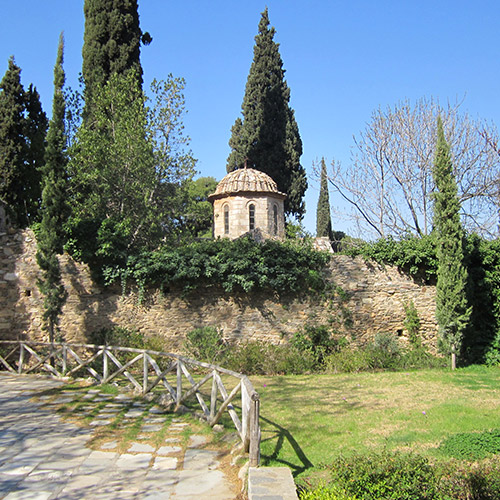

The Aesthetic Forest is located on the West side of Mt. Hymettus, in Attica, and borders, to the North, the East and the South on the rocky slopes of Hymettus and, to the West, on the University Campus (National and Kapodistrian University of Athens), the Kaisariani and Vyronas municipalities. It spans over an area of 446 ha. The whole area, successfully reforested by Philodassiki, was declared an “Aesthetic Forest” in the Presidential Decree (PD) 71/94. The Aesthetic Forest spreads across the city from one side all the way to the rocky slopes of Mt. Hymettus at the height of 760 meters. The Iridanos and Coutalas streams cut through the forest from east to west and are practically dry. The reforestation efforts in the Aesthetic Forest as a whole, resulted in the creation of a mosaic of plant formations in which the species Pinus halepensis and P. brutia (pine trees) are dominant, in unmixed clusters or interwined with Cupressus sempervirens (cypress tree) and broad leaved trees such as Cercis siliquastrum (judas tree), Ceratonia siliqua (carob tree) and Quercus pubescens (oak). In the rocky areas there are pine trees together with Quercus coccifera (kermes oak) and Olea europaea (olive tree).



Species
The flora of the Aesthetic Forest consists of the following plant species which were used during reforestation efforts from the Philodassiki and the Ministry of Agricultural affairs. Pinus brutia (Calabrian pine), Pinus halepensis (Aleppo pine) Pinus pinea (Umbrella pine). Cupressus sempervirens, Cercis siliquastrum (Judas tree), Quercus pubescens (Oak), Quercus ilex (Holm or Evergreen oak), Ceratonia siliqua (Carob tree), Cupressus arizonica var. glabra (Arizona cypress), Quercus coccifera (kermes oak). Along with the above mentioned, the following plants were also sporadically planted in the Aesthetic Forest: Quercus ithaburensis ssp. Macrolepis (Valonia oak), Acacia saligna (blue-leaved wattle), Eucalyptus globulus (eucalyptus trees), Schinus molle, Pyrus amygdaliformis and Platanus orientalis (oriental planes). In the open sites and in the recently reforested parts of the forest, the low thorny xerophytes and with a cushion shape shrubs called phrygana in Greece mainly contain the following: Sarcopoterium spinosum, Phlomis fruticosa, Thymbra capitata, Cistus salviifolius, Cistus creticus, Euphorbia acanthothamnos, Genista acanthoclada, Fumana thymifolia, Hypericum empetrifolium, Satureja thymbra, Calycotome vilosa, Anthyllis hermaniae, Globularia alypum, Thymelaea tartonraira, Balotta acetabulosa etc.


 More information
More informationHow to participate
The Bioblitz in the Kaisariani Aesthetic Forest, (Athens, Greece) is a two-day event held as part of the European ALIEN CSI Bioblitz event under the Alien-CSI COST Action. It will take place between Friday and Sunday the 26th and 28th of May, 2023. We aim to improve knowledge of the biodiversity of Kaisariani Aesthetic Forest and identify potential risks to the biodiversity caused by invasive species. Our goal is to engage students of the Department of Biology NKUA and citizens to participate in such environmentally important events. In order to participate please contact us before on the following emails:
marianou@biol.uoa.gr
ibazos@biol.uoa.gr


